November 21, 2025 | 19:01 GMT +7
November 21, 2025 | 19:01 GMT +7
Hotline: 0913.378.918
November 21, 2025 | 19:01 GMT +7
Hotline: 0913.378.918
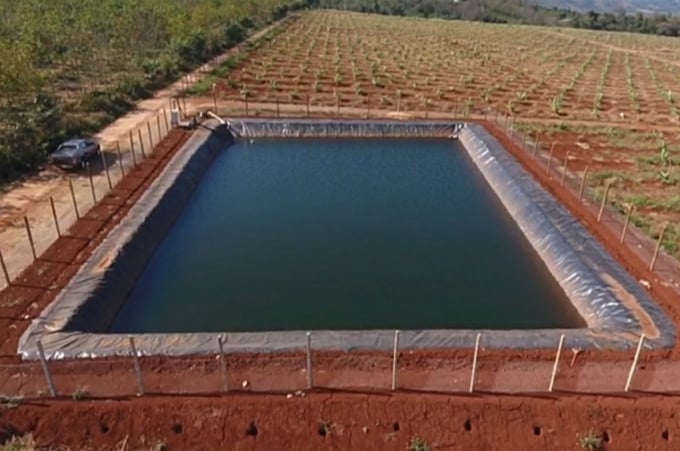
The reservoir pond of La Canh Cuong's family is 600 m2 wide, providing enough irrigation water for 22 hectares of durian in the dry season. Photo: M.P.
La Canh Cuong is developing a durian-banana mix cropping model in Hoa Thang commune (Buon Ma Thuot city, Dak Lak province) in accordance with the principles of organic agriculture. The columns of three-year-old durian trees intermingled with banana plants continue to grow horizontally green on his 22-hectare property.
Cuong said that durian plants need enough irrigation water during their peak growing season. The dry season in Dak Lak and the Central Highlands is usually six to seven months long; as a consequence, without a solution to maintain a proper level of humidity in the orchard grounds, the trees would dry up, lose their leaves, and eventually die.
Cuong said, "I grow about 5,000 durian roots and tens of thousands of bananas on a 22-hectare plot." To provide water to such a vast area, I dug a pond directly in the orchard.”
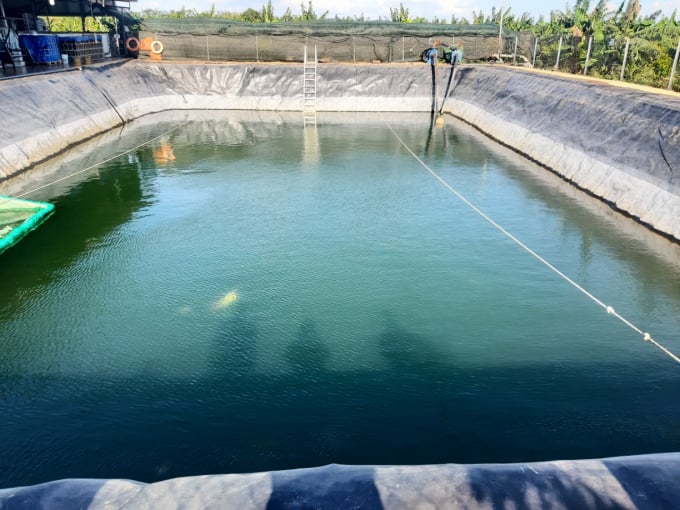
The water in the pond is taken from groundwater, which is very clean. Photo: M.P.
Cuong referred to a pond that is about 600 m2 in width, 4 m in-depth and has a storage capacity of approximately 1,600 m3. The garden owner arranged four dug wells and built pumps to push water to the reservoir.
When water enters the lake, it is stored, settled, and tested on a regular basis to guarantee its cleanliness. The gardener builds a large-capacity pump system from this pond to push water up to contemporary pipes, which are then routed to each tree stump using an inexpensive watering technique.
According to Cuong, with the present dry season and water shortage, spraying and watering each tree in a conventional manner consumes a significant amount of water, effort, time, and money while achieving a poor level of efficiency. As a result, his family built an inexpensive local irrigation system to efficiently utilize water from a small pond in the yard.
This kind of watering conserves water, maintains a consistent humidity level on the garden floor, and minimizes work, according to Cuong.
Additionally, the construction of water storage works is distinct from that of many adjacent homes. Rather of excavating the ground and covering it with cement and concrete, Cuong constructed the structure by unearthing it and lining it with HDPE tarpaulin. This tarpaulin is about 1mm thick and costs VND 70,000 per m2.
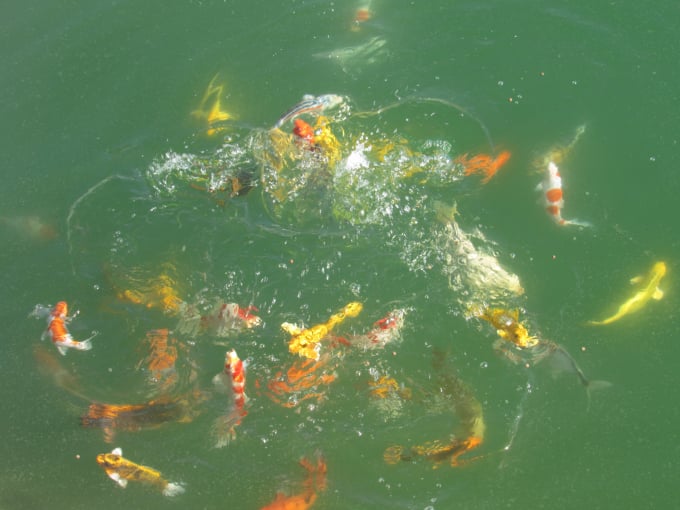
Cuong raises Koi fish in a pond containing water to irrigate durians. Photo: M.P.
This plastic tarpaulin is very durable, has a high degree of elasticity, and has a lifetime of more than ten years, he said. Additionally, since the plastic sheet is elastic, there is no risk of cracking or water absorption, as there is with concrete. If the plastic becomes perforated, just repair it with adhesive or seal it with heat.
Cuong's calculations indicate that digging a reservoir to store water is very effective. He just needed to dig four wells and pump water into the pond at night to accumulate and sustain the source, while watering the trees during the day. The investment cost for the underground pipeline system is about VND 25 million per hectare. The cost of installing four pump motors in four wells and a high-capacity pump at the lake is about VND 100 million.
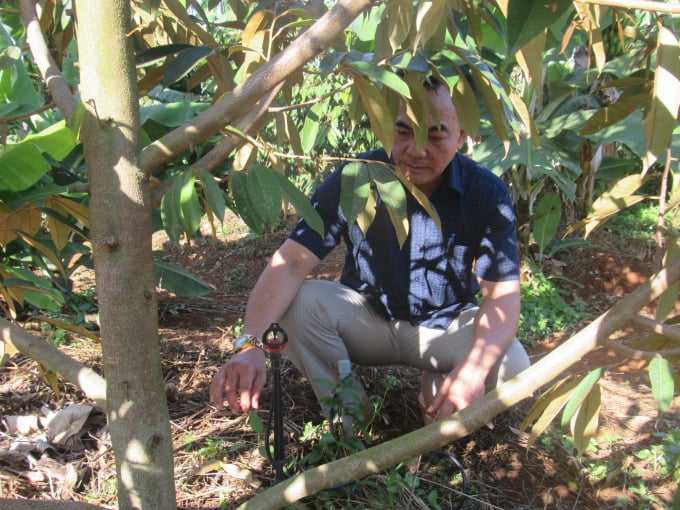
The water source from the pond irrigates durian by the method of economical sprinkler irrigation. Photo: M.P.
He observed that the garden's durian trees are thriving, requiring 3-5 liters of water per root, while banana plants likewise need 10-15 liters of water each day. To save water while yet providing sufficient water for plants, his family uses a sophisticated and programmed irrigation system.
In the long run, the garden owner reasoned, when durian reaches the commercial stage, the tree has reached a certain size and its roots are firmly entrenched in the earth, requiring less water than the period required to plant. Additionally, during the durian season, the garden owner will restrict the number of bananas planted, allowing the water supply from the 600 m2 lake to have enough water to irrigate the whole 22 ha garden.
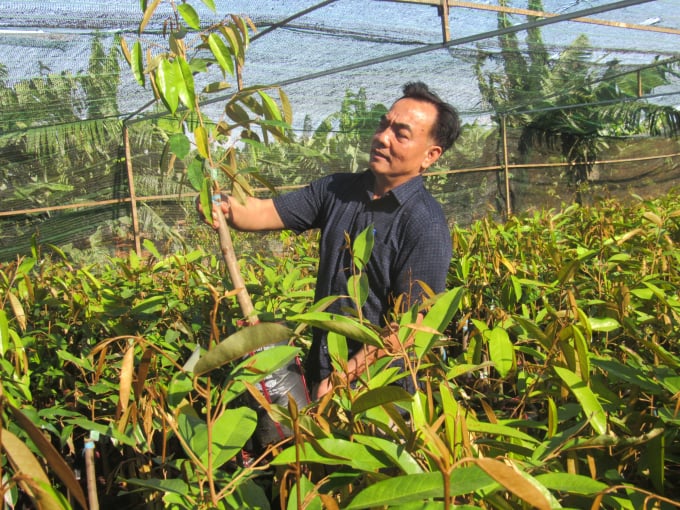
La Canh Cuong inspects durian seedlings before planting. Photo: M.P.
Currently, in addition to the reservoir pond system used to store water for the commune's 22-hectare orchard. Additionally, La Canh Cuong's family is planting a 30-hectare durian model in Krong Buk district (Dak Lak), which will be watered by the same model.
Cuong's family spends less than VND10 million per month on energy to run the irrigation system for the whole 22-hectare garden. The concept of excavating ponds to retain water and smoothing the bottom with plastic tarpaulins has produced amazing results in comparison to the conventional approach.
As a result, several farmers in the region have lately paid visits to his garden to study and then implement what they've learned in production. This type of water storage conserves water, effort, and investment expenses while maintaining a high level of efficiency.

(VAN) Results from the Sustainable Durian Model Project in Dak Lak have confirmed the critical role of Yara Viet Nam in transferring advanced nutritional solutions to farmers.

(VAN) In Tuyen Quang province, livestock farmers have introduced effective models and innovative practices that significantly strengthen African Swine Fever prevention and control efforts.

(VAN) This is the study conducted by IRRI and Can Tho University on the rice straw value chain in Mekong Delta showing an economic potential of more than 6.6 trillion VND/year.

(VAN) By participating in cooperative economics, many farmers in Tay Ninh have overcome hardship, mastered clean dragon fruit cultivation techniques.

(VAN) The crossbreeding program in the former Binh Dinh province (now part of Gia Lai) has shown signs of decline, and urgent measures are needed to revive it and sustain past achievements.

(VAN) The agricultural sector agreed on a roadmap to pilot the MRV protocol and expand low-emission rice production from the 2025-2026 winter-spring crop.

(VAN) Agricultural extension officers in Quang Ninh do more than transmit knowledge; they have become a steadfast support system for farmers on the path to sustainable agricultural development.